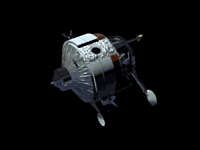Kvant 1
Part of the Mir Space Station program
 The Kvant ('Quantum') 1 module was the first addition to the Mir core and contains a suite of scientific instruments for astrophysical observations and materials science experiments. The purpose of Kvant 1 is to provide data and observations for research into the physics of active galaxies, quasars and neutron stars. The module also supports biotechnology experiments in the areas of anti-viral preparations and fractions.
The Kvant ('Quantum') 1 module was the first addition to the Mir core and contains a suite of scientific instruments for astrophysical observations and materials science experiments. The purpose of Kvant 1 is to provide data and observations for research into the physics of active galaxies, quasars and neutron stars. The module also supports biotechnology experiments in the areas of anti-viral preparations and fractions.
Kvant 1 docked with the Mir station on April 12, 1987 at the Mir core module aft axial port. The module is divided into a pressurized laboratory compartment (40 cubic meters total pressurized volume) and a non-pressurized equipment compartment. The laboratory compartment is further divided into an instrumentation area and a living area, which are separated by an interior partition. A pressurized transfer chamber connects the core module with the laboratory chamber. The nonpressurized equipment contains power stabilizers.
After docking, Kvant 1 successfully operated until fall 1989, at which time operation was stopped for a planned reconfiguration of the Mir station. Kvant was restarted in October 1990 with calibration observations showing no apparent degradation from the year off.
In addition to its primary scientific equipment, the module also carries gyrostabilizers designed to improve the stability of the entire station and reduce propellant consumption. Kvant 1 also carries additional life support equipment. Two external masts, erected by cosmonauts on the outside of Kvant 1, are used for a variety of experiments.
Spacecraft
The module is equipped with geodyne momentum wheels to replace the Mir core thruster system for routine attitude pointing. Attitude control thrusters were added to one of the external masts in 1992 to reduce fuel consumption of pointing maneuvers. One solar array wing from the Kristall module was transferred to Kvant 1 in 1992. 2 new solar arrays (12 kW total) were delivered in 1995 to replace Kristall array. Initial docking maneuvers were performed by a service module which was jettisoned following docking. 2 Earth horizon sensors, 2 star sensors, and 3 star trackers are used for attitude knowledge.
Payload
TTM Coded Mask Imaging Spectrometer - a wide-angle camera that uses a coded aperture mask to determine source location. It covers the energy range 2-30 keV with a 7.8 deg x 7.8 deg field of view. It can achieve an angular resolution of 2 arcminutes and a time resolution of 1 s. Provided by the Netherlands/UK.
HEXE (High Energy X-ray Experiment) - 4 detectors that cover the 15-200 keV energy range. The instrument has a 1.6 x1.6 deg field of view and has a maximum time resolution is 0.3-25 ms. Provided by West Germany.
Sirene 2 Gas Scintillation Proportional Spectrometer - a gas scintillation proportional counter that covers the 2-100 keV energy range. It has a 3 x 3 deg field of view with a maximum time resolution of 1.25-2.5 ms. Provided by ESA.
Pulsar X-1 - 4 phoswich detectors that cover the 20-1300 keV energy range. It has a 3 x 3 deg field of view with a maximum time resolution of 10 s. Provided by the USSR.
These experiments, taken together, are sometimes referred to as the Roentgen Observatory. All 4 experiments point toward the same source at the same time.
Glazar UV Spectrometer - covers wavelengths between1150-1350 angstrom. The instrument can provide up to 1-2 angstrom resolution and has a 1.3 deg FOV.
Mariya magnetic spectrometer - measures high-energy electron and positron fluxes in near-Earth space.
Arfa-E - installed on the exterior of the module in January 1990 to investigate the Earth's ionosphere and magnetosphere by injecting electron beams perpendicular to the geomagnetic field.
| Country of Origin | USSR |
| Size | 5.8 m long x 4.15 m diameter |
Launch Facts
| Name | Int'l Desig. | Date | Site | Vehicle | Orbit | Mass(kg) |
| Notes | ||||||
| Kvant 1 | 1987-030A | 3/31/87 | Tyuratam | SL-13 | LEO | 20000 |
| MIR module; high energy observatory | ||||||
Information in The Mission and Spacecraft Library is provided without warranty or guarantee. USE AT YOUR OWN RISK.